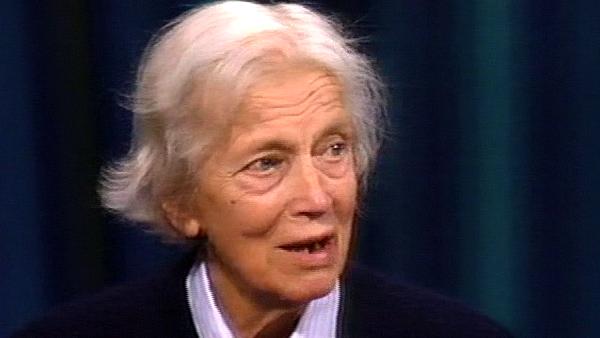NEXT STORY

Mapping the molecular structure of penicillin
RELATED STORIES

NEXT STORY

Mapping the molecular structure of penicillin
RELATED STORIES



|
Views | Duration | |
|---|---|---|---|
| 21. Working on cholesterol | 133 | 04:41 | |
| 22. Determining the chemical structure of penicillin | 160 | 06:39 | |
| 23. Work on penicillin | 101 | 03:34 | |
| 24. Crystallising penicillin | 85 | 04:25 | |
| 25. Photographing potassium, rubidium and sodium salts | 56 | 04:26 | |
| 26. Mapping the molecular structure of penicillin | 101 | 06:38 | |
| 27. Correlating the work on penicillin | 59 | 02:18 | |
| 28. Computing solutions for the structure of penicillin | 73 | 04:29 | |
| 29. My molecular model of penicillin | 94 | 03:27 | |
| 30. Visiting America | 109 | 02:12 |


I mean, the thing we were wanting to do was to jump to the actual structure straight away from the crystal. And we were, when we had finished photographing this crystal, of course we had all the data that there was, but later on the same year, I think, this photography of the first sodium salt took place in February and I think it was somewhere about April that the potassium and rubidium salts were made for us by ICI, and sent also. And we photographed the whole of them also, and we built three-dimensional data from scratch.
[Q] And the significance of those, if they were going to help solve the phase problem and give you the electron density calculations in an interpretable distribution?
Yes, yes. In fact, of course, the three salts were not isomorphous. The potassium and rubidium salts were, and then the sodium salt was monoclinic, with a smaller unicell. And that determined a different course of action in its solution, but the obvious thing was to do Patterson's on all three, which we could calculate ourselves if we just did the two-dimensional ones, and place the heavy atoms, which we did for the potassium and rubidium, but not for the sodium ones from... I know... actually, if we'd held it all in our hands all the time, we probably should have, because the later potassium and rubidium salt positions. But, in fact, wanting to go faster to an actual analysis, I decided it would be good to use the X-ray microscope, and Charles Bunn had built one in his spare time in Alkali Division, Northwich.
And we took the children to a farm in the country, in the Easter vacation, so that I could go over to Charles and work with him in the evenings, and look after the family for the rest of the day. It was a quite serious moment of the war, we used to sort of look out at... every night. On the one side it was Manchester and towns over that side were being bombed and going up in flames from time to another, while the other side would be Stoke doing the same. And Thomas would go out lecturing every now and again to one part or the other, and he was officially fire-watching for Stoke, the other side. Once I went in with him to his lectures, and a bomb fell very near us, and everyone in his lecture class just dived under the table for the next few minutes, then we rather sheepishly got out again when we were obviously safe. And I was always sorry we hadn't actually gone down and helped those who were digging for people out of where the bomb had come down, because it had come down on Bob Stross, a friend of Thomas's, and he was half buried in debris.
British pioneer of X-ray crystallography, Dorothy Hodgkin (1910-1994), is best known for her ground-breaking discovery of the structures of penicillin, insulin and vitamin B12. At age 18, she started studying chemistry at Somerville College, Oxford, then one of the University of Oxford colleges for women only. She also studied at the University of Cambridge under John Desmond Bernal, where she became aware of the potential of X-ray crystallography to determine the structure of proteins. Together with Sydney Brenner, Jack Dunitz, Leslie Orgel, and Beryl Oughton, she was one of the first people in April 1953 to see the model of the structure of DNA, constructed by Francis Crick and James Watson. She was awarded the 1964 Nobel Prize in Chemistry and is also known for her peace work with organisations such as Science for Peace and the Medical Aid Committee for Vietnam. All recorded material copyright of The Biochemical Society.
Title: Photographing potassium, rubidium and sodium salts
Listeners: Guy Dodson
Guy Dodson studied chemistry and physical science at the University of New Zealand, followed by a PhD on the crystallographic study of an alkaloid. In 1961, he came to Oxford to work on the crystal structure of insulin. In the mid 1970s Guy and his wife moved to York University to establish a laboratory. In addition to insulin studies the laboratory has investigated many complex molecules of medical significance, including haemoglobin, myoglobin, HIV related proteins, proteases and proteins involved in managing nucleic acids in cells. In 1993, he went to the NIMR in London to establish a crystallographic group in an environment that spanned molecular, physiological and disease-related disciplines. Here his research began on some cell signalling proteins. His interests on medically relevant proteins included prions, malarial and TB proteins, and some clinically relevant thrombin inhibitors. Guy Dodson retired in 2004 but is still finding much to do in York and the NIMR.
Tags: crystal, photography, sodium salt, potassium salt, rubidium salt, heavy atoms, x-ray microscope, bomb
Duration: 4 minutes, 26 seconds
Date story recorded: 1990
Date story went live: 02 June 2008